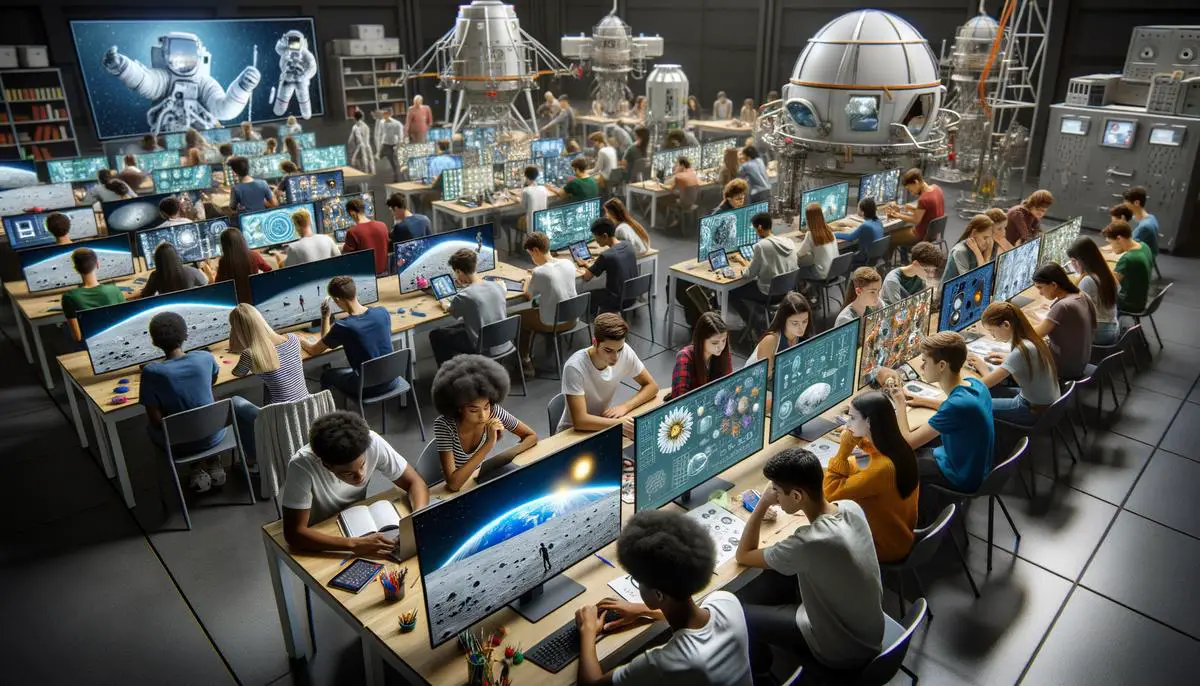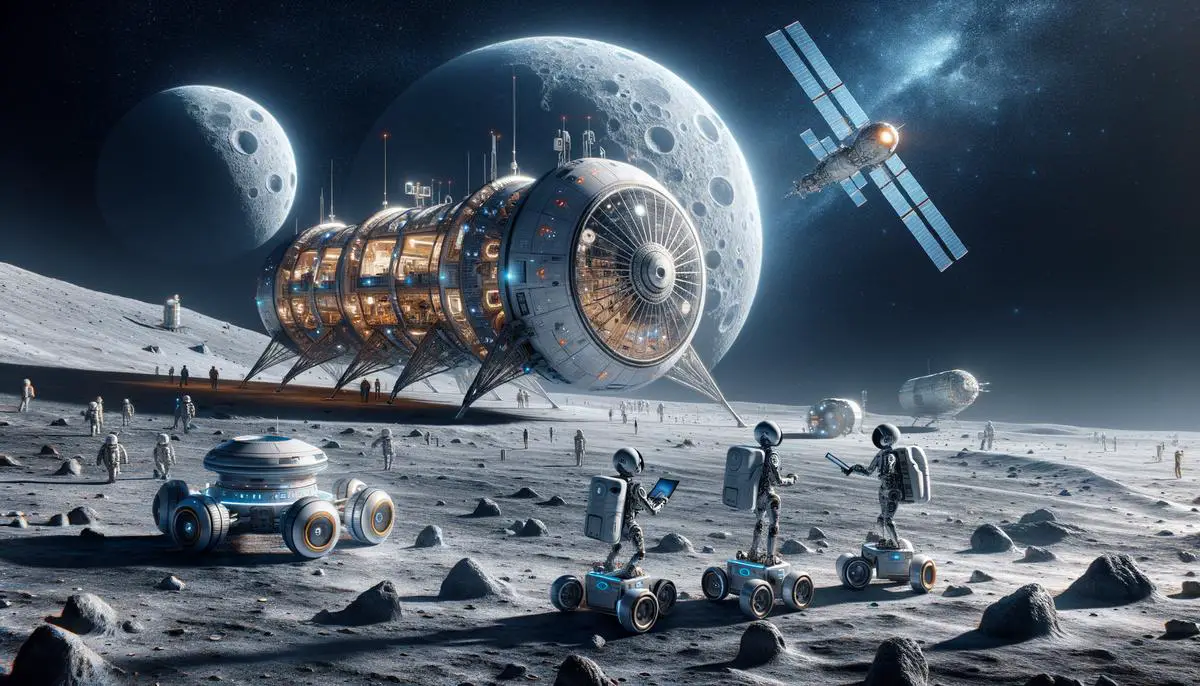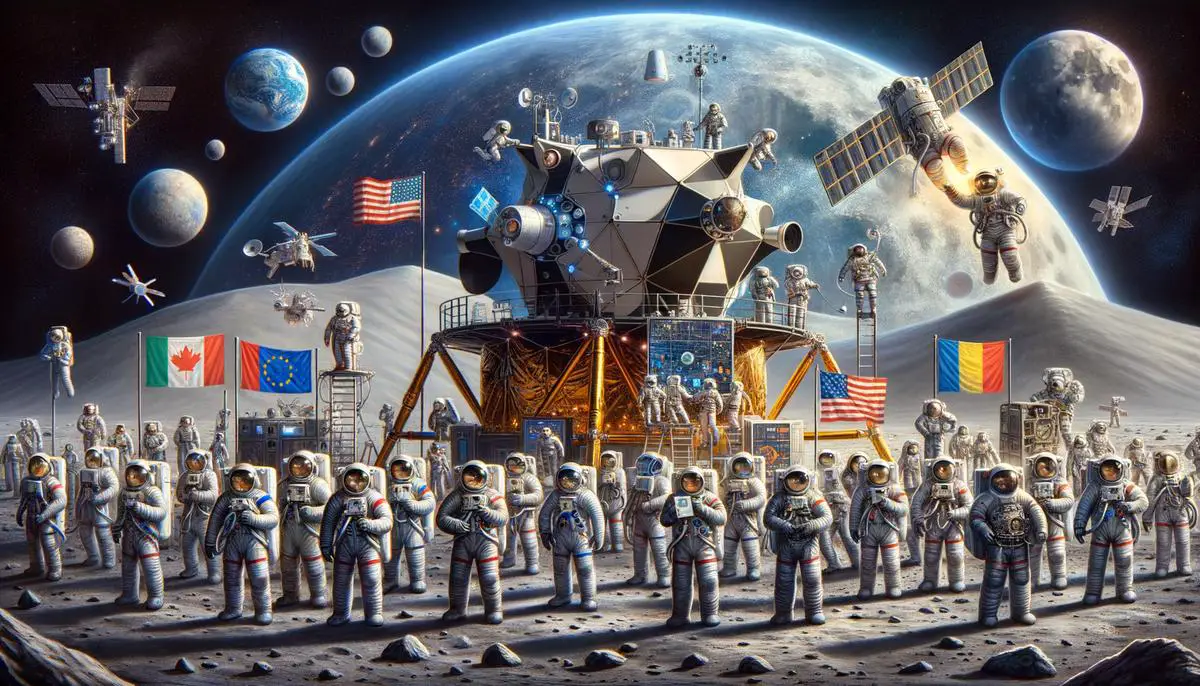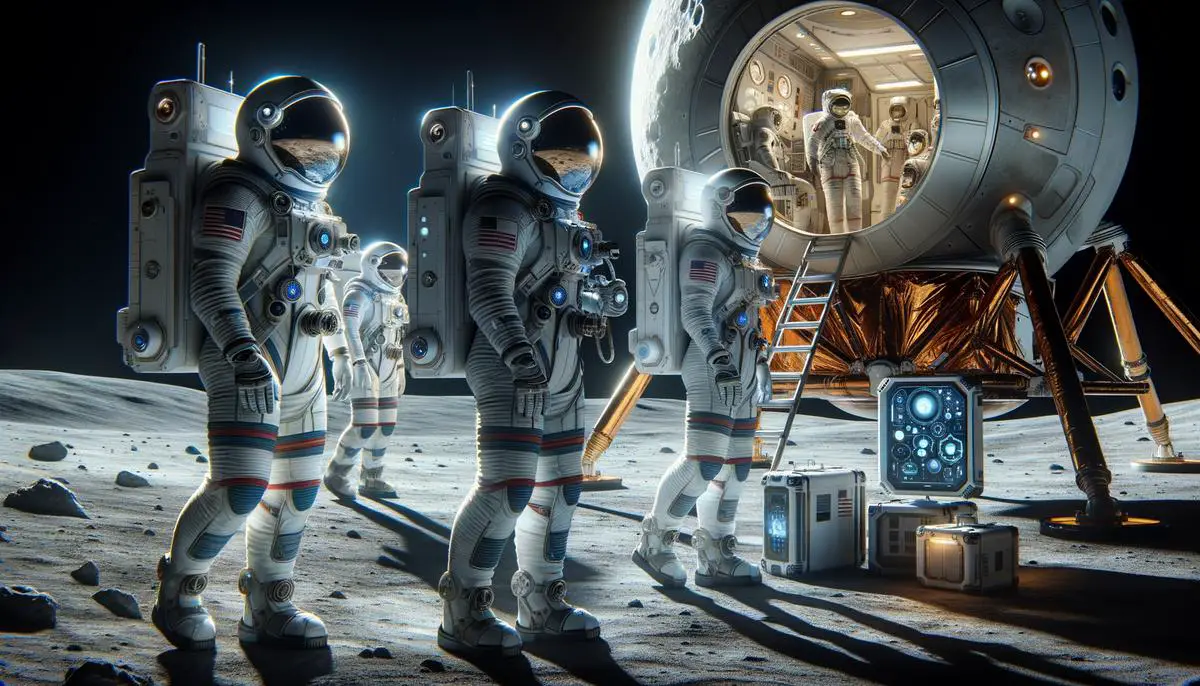NASA's Artemis program presents an ambitious vision that goes beyond lunar visits. It aims to establish a sustainable presence on the Moon, preparing for future generations to live and work in space. This goal is a significant step for space agencies and humanity, broadening our horizons and deepening our understanding of what it means to explore beyond Earth.
Contents
Artemis Overview
NASA's Artemis program aims to send humans back to the Moon for the first time since the Apollo missions. It's not just about taking a few steps and returning; it's about staying, learning to live and work on another world. The Moon serves as a testbed for living off-planet, and by using its resources, like water ice for drinking water or rocket fuel, astronauts will prepare for longer trips, such as to Mars.1
Artemis will see astronauts landing on the lunar South Pole, a resource-rich area with nearly continuous sunlight for solar power. The program plans to include the first woman and the next man on the Moon, as well as international partners and commercial companies in future missions.2 By including diverse perspectives, Artemis creatively tackles challenges and ensures space exploration benefits everyone.
The program aims to establish a permanent base on the Moon by the end of the decade, serving as a launchpad for missions deeper into space, particularly to Mars. Before humans return, robotic missions will map the lunar surface, search for resources, and perform risky tasks to ensure safety for the astronauts.
Technology developed for Artemis could also have Earth applications, such as solar power technologies, water purification, and new materials. Pushing the boundaries of human achievement inspires future generations to dream big and work hard.
Artemis is more than just going to the Moon; it's about advancing space exploration, enabling humans to live and work on other planets, sparking innovation, and uniting us for a significant cause.

Educational Impact
The Artemis program's impact on STEM education is significant. NASA is eager to partner with educational institutions, offering:
- Hands-on experience
- Access to scientists and engineers
- Payload space for student experiments
Imagine a student experiment flying to the Moon!
NASA and its partners are developing interactive educational materials, such as:
- Simulations for designing lunar habitats
- Virtual reality tours of Artemis space vessels
- Augmented Reality (AR) experiences that bring the Moon to life in the classroom
These "current events" curricula elevate the relevance and excitement of learning, connecting students with ongoing missions.
Artemis addresses the historic shortfall in STEM disciplines by intersecting with education at multiple levels, generating a reserve of qualified, enthusiastic problem solvers ready to take humanity further into the cosmos. The program serves as an opportunity for inclusion, emphasizing the variety of roles critical to successful space exploration. It illustrates that the path to impactful STEM careers is as diverse as the lunar landscape, forged by the contributions of scientists, engineers, storytellers, and dreamers alike.
The influence of Artemis on STEM education transcends science textbooks; it's a narrative where every passionate teacher or curious student could play a pivotal role. As Artemis launches, it's not just a mission taking off—it's an invitation to tomorrow's pioneers to dream bigger, reach further, and maybe one day leave their footprints among the stars.

Technological Innovations
Redefining Spacecraft Design: The Orion and Beyond
The Orion spacecraft boasts an advanced design, incorporating materials that can withstand harsh entry, descent, and landing processes. Equipped with a service module providing air, water, and propulsion, Orion pushes the boundaries of human engineering.3 Its state-of-the-art navigation systems and reusability underscore a shift towards sustainability in space travel.
Life Support Systems: A Breath of Fresh…Space
Artemis's life support systems are groundbreaking, designed to recycle air and water with unprecedented efficiency in a compact and reliable manner over extended periods. This technology has implications for water purification and air recycling solutions in resource-scarce areas on Earth.
Hands, Eyes, and Wheels on the Moon: The Robotic Pioneers
Artemis's robotic missions deploy advanced rovers, landers, and instruments representing the pinnacle of autonomous technology and remote sensing capability. These AI-driven robots can navigate the Moon's treacherous terrain, search for water, conduct seismic studies, and gather geological data, minimizing risk and maximizing scientific return.
From Moon Boots to Martian Hikes: Bridging Worlds with Technology
Artemis's innovations in propulsion systems, habitat construction, and environmental control have Mars in their sightlines. Every step on the Moon is a leap towards the Red Planet.
Earthly Sciences: The Unintended Beneficiaries
The technologies developed for Artemis have potential terrestrial applications, from propulsion technologies revolutionizing transport to life support system innovations advancing sustainable living. The robotics tech has applications in unfriendly environments on Earth, from deep-sea exploration to disaster zones.
Artemis touches down on the Moon, signaling humanity's drive to explore — the desire to not just reach for the stars but to create worlds anew. It paves the way for a future where Earth and space share a technologically symbiotic relationship.

International Collaboration
When NASA named its moonward mission Artemis, after Apollo's mythological twin sister, it wasn't just planning a family reunion on the Moon's surface. It was setting the stage for an international collaboration—one where every partner brings unique capabilities and expertise. In space exploration, diversity breeds innovation and resilience. The Artemis program is a testament to that truth, weaving a tapestry of international cooperation that could redefine the realms of possibility.
A Symphony of Global Contributions
The European Space Agency (ESA), the Canadian Space Agency (CSA), and the Japan Aerospace Exploration Agency (JAXA), among others, each bring a unique instrument to the ensemble, harmonizing the melody of moonward ambition.
ESA contributes to the Service Module of Orion, which brings power, propulsion, and life essentials—like air and water. It ensures that astronauts will have the necessary resources during their lunar mission.
The Canadian Space Agency brings us the robotic arm known as Canadarm3. This mechanical marvel will construct and maintain infrastructure in lunar orbit. It demonstrates Canada's expertise in robotic technology and its applications in space exploration.
JAXA contributes technological advancements in the form of sophisticated navigational technology, robotic support systems, and innovative gadgets. Their tech promises to enhance lunar habitat setups and potentially introduce high-speed internet to the Moon.1
Harmony and the Hunt for Knowledge
This international collaboration isn't all about infrastructure and technology. At its core, the essence of Artemis's international collaboration lies in its commitment to the pursuit of knowledge—a sentiment that resonates across cultures and continents.
Each partner in this lunar consortium contributes data, expertise, and perspectives that enrich the collective understanding of space. From revealing lunar secrets locked within regolith to safeguarding astronauts against space's harsh realities, the collaborative efforts stretch far beyond mere technological marvels. They're crafting a knowledge legacy that will outlive initial moon landings and pave the way for sustainable human life beyond Earth.
Uniting Nations, Inspiring Humanity
The vision of diverse nations working together in the name of exploration is significant. It suggests that if we can cooperate on this scale in space, there's hope for our collaborative efforts on Earth.
Artemis acts as a beacon of inclusivity and shared wonder. It invites the world to participate in the unfolding story of humanity's steps among the stars. This global endeavor showcases not only the technical achievements humanity can attain when it acts as one but also reignites a unifying spark of awe and adventure that transcends boundaries.
As we stand on the precipice of our collective return to the Moon, the Artemis program illuminates the path forward—a path paved by the hands of many, stretching across the globe. In doing so, it fosters international cooperation not as a lofty ideal but as a pragmatic blueprint for space exploration and beyond.
This ever-expanding alliance promises that when humanity once again leaves its footprint on the lunar surface, it will be a collective achievement, representing shared dreams and hard-earned unity. And in that moment, Artemis will have transformed from a mission to a milestone—not only in space exploration but in how we view our place in this vast cosmos, together, as citizens of Earth.

Public Engagement
Engaging the Public: NASA's Bid to Bring the Artemis Program to the World
In an era where you can live stream a rover landing on Mars from your smartphone, the Artemis program sets a new standard for public engagement. Leveraging everything from apps to social media campaigns, Artemis isn't just a mission; it's a masterclass in public outreach. Let's explore the strategies NASA uses to bring space closer to the public, igniting imagination and rallying support for our next giant leap.
Educational Outreach
NASA's educational outreach is at the core of Artemis's engagement strategy, presenting the future of space exploration as an inclusive, hands-on experience. Programs like "Next Gen STEM" offer Artemis-themed lesson plans that make space exploration accessible and engaging for students. It's education with a focus on inspiring the next generation of space enthusiasts.2
Social Media Presence
NASA's social media strategy turns platforms like Twitter, Instagram, and even TikTok into Earth's connection to Artemis's aspirations. NASA feeds feature stunning visuals, launch countdowns, and interesting space facts. They engage the public through catchy hashtags and trending topics.
Public Events: Rocket Launches Turned Blockbusters
Public events around launches and major milestones are open invitations to witness history—live and unfiltered. Streaming services blend with physical viewing locations for launches, allowing millions to experience humanity's journey back to the lunar surface. It's a collective experience that unites people in a shared moment of awe.
Astronauts: Humanity's Spaceborne Avatars
Astronauts serve as storytellers and ambassadors, representing Earth on the Moon. Through interviews, personal stories, and behind-the-scenes glimpses into their training, these explorers become symbols of human potential and resilience. They embody a collective human endeavor, proving that the stars are within our reach.3
Every tweet shared, every classroom visited, and every launch watched live turns spectators into stakeholders, weaving the public into the fabric of Artemis's narrative. This isn't just NASA's mission; it's humanity's. By sparking interest, stirring imagination, and rallying support, Artemis champions a unifying quest for knowledge that transcends borders.
The effectiveness of NASA's public outreach lies in crafting an expansive space saga where everyone's invited. When those first boots print their mark on lunar regolith once more—whether followed through a live stream or witnessed firsthand from a viewing party—the sense of achievement will resonate through communities far and wide. Through Artemis, NASA ensures our next "small step" is also humanity's collective leap into the future.

